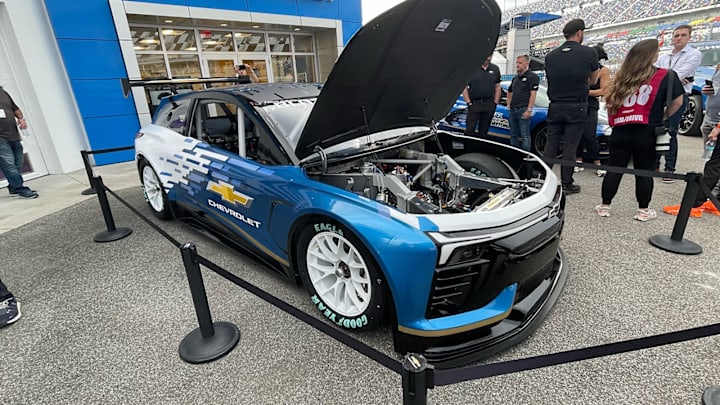Justin Allgaier Dishes on Testing Chevrolet Blazer EV.R NASCAR Prototype

Justin Allgaier, who will continue to attempt working his way into the Daytona 500 starting field as he pilots the No. 40 JR Motorsports Chevrolet in Thursday's NASCAR Cup Series Duel Qualifiers at Daytona International Speedway, was on hand to help Chevrolet unveil the manufacturer's latest project, the Blazer EV.R NASCAR Prototype race car.
A better look at the Chevy EV.R #NASCAR Prototype that was just unveiled here at Daytona. pic.twitter.com/uM86vCXhwE
— Toby Christie (@Toby_Christie) February 13, 2025
Allgaier, who tests Chevrolet's Wheel-Force Next Gen car, was invited to test the car at Carolina Motorsports Park in Kershaw, South Carolina in a joint EV NASCAR Prototype test alongside NASCAR's previously revealed ABB EV car. According to the veteran racer, it was a moment he'll not soon forget.
"It was a really unique experience, and again, just really thankful that they let me be a small part of it," Allgaier said in a media scrum session following the public unveil of the prototype race car. "Because it was a really cool experience."
According to Chevrolet, the Blazer EV.R was built with a modified NASCAR Next Gen chassis, and the car features 1,300 horsepower, a truly beefy amount by current NASCAR National Series standards. Allgaier found out just how intense the car could be around the 2.27-mile road course.
"I actually, unfortunately, found the limits in one of the laps, I went off and made an excursion through the grass into the sand," Allgaier said. "It was quite an interesting experience."
Allgaier noted the thing that sets the Chevrolet Blazer EV.R NASCAR Prototype apart from the traditional gasoline-powered NASCAR stock cars was the level of adjustability within the car.
"With a fully electrical system, there's a lot of tune tuning to be done. Way different from what we're used to on the traditional NASCAR style of things," Allgaier explained.
According to Allgaier, when he first got behind the wheel, Chevrolet had the regen settings, which produce additional stopping power, turned off. Out of the box, Allgaier said the car felt very similar to drive when compared to the NASCAR Next Gen car. However, the game changed once Chevrolet dialed up the regen in the Blazer EV.R.
"And then we turned the regen on at a fairly low rate for the first time and I immediately came on the radio and said, 'Holy cow, this is significantly different.' And it really was," Allgaier recalled. "And when we adjusted on it over the course of the test, tried to understand it a little bit better, I still have a couple of more questions than I had answers from that test as far as the regen goes. But it was amazing to watch what was available, and how different it could be, and what we were able to learn."
Other adjustments that can be done on the Blazer EV.R include motor mapping tuning, the ability to control how torque is applied, and the ratio of front-wheel to rear-wheel drive adjustable.
While adjusting to the regen was a challenge, Allgaier said overall, the driving style of the Blazer EV.R was very similar to traditional NASCAR race cars.
"The driving style, though, is actually very, very similar. You fight a lot of the same balance issues. The cars are very naturally balanced like a traditional NASCAR stock car would be. I think all of the technology from the Next Gen car has gone into the chassis of this car. So, it didn't drive as differently as I thought it would other than you havemore control over the tuning."
The biggest challenge in piloting an EV race car, in Allgaier's opinion, was the sound that the car emits while pushing it to the limit as it is a stark contrast from what he's used to.
"The only thing I would say was difficult for me was the sound. When you're pushing the limits of a race car, a lot of us as drivers, we go off of that seat-of-the-pants feel, but you also go off of the sound and what you're hearing audibly. With this car, there's still a sound to it, but it's just a very different sound," Allgaier stated. "It's more of the driveline and the hum of the motors."
So, what's the future for Chevrolet's Blazer EV.R NASCAR Prototype? That remains to be seen. There have been persistent rumors for a couple of years that NASCAR is ramping up to form some form of an EV Series, but the sanctioning body has denied those rumors at this time. However, even if a series never materializes, the NASCAR, Chevrolet, and Ford EV prototypes have been a cool showcase of technology that can be used to create a NASCAR stock car.
Recommended Articles

Toby Christie is the Editor-in-Chief of Racing America. He has 15 years of experience as a motorsports journalist and has been with Racing America since 2023.
Follow toby_christie